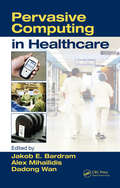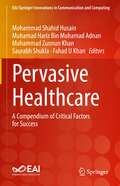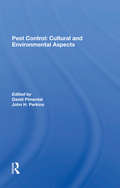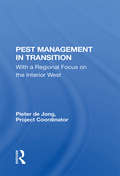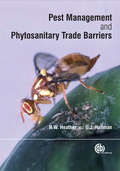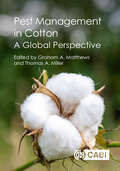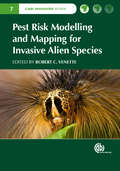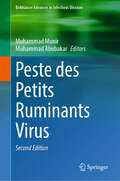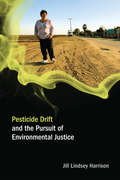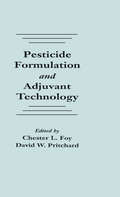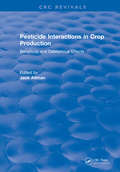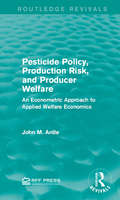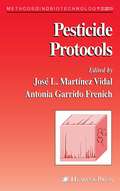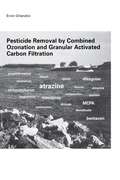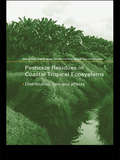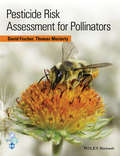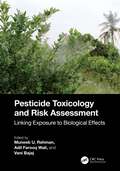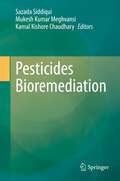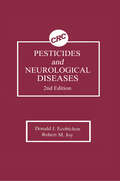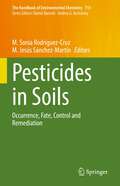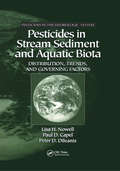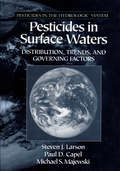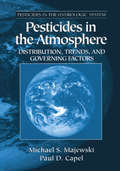- Table View
- List View
Pervasive Computing in Healthcare
by Jakob E. Bardram Alex Mihailidis Dadong WanWith skyrocketing costs due to the increase in the elderly population, a rapid increase in lifestyle-related and chronic diseases, demand for new medical treatments and technologies, and a shortage in the number of available clinicians, nurses, and other caregivers, the challenges facing the healthcare industry seem insurmountable. However, by tra
Pervasive Healthcare: A Compendium of Critical Factors for Success (EAI/Springer Innovations in Communication and Computing)
by Saurabh Shukla Mohammad Shahid Husain Muhamad Hariz Bin Muhamad Adnan Mohammad Zunnun Khan Fahad U. KhanThis book provides in depth knowledge about critical factors involved in the success of pervasive healthcare. The book first presents critical components and importance of pervasive healthcare. The authors then give insight into the pervasive healthcare information systems and key consideration related to remote patient monitoring and safety. The book provides in-depth discussion about the security issues and protocols for pervasive healthcare. This book explores concepts and techniques behind the successive pervasive healthcare systems by providing in-depth knowledge about patient empowerment, remote patient monitoring, network establishment and protocols for effective pervasive healthcare. The book also provides case studies in the field. It is an ideal resource for researchers, students and healthcare organizations to get insight about the state of the art in pervasive healthcare systems.Provides current research, developments, and applications in pervasive healthcare;Includes technologies such as machine learning, cryptography, fog computing, and big data in the advancement of e-healthcare;Pertinent for researchers, students, practitioners and healthcare decision makers.
Pest Control: Cultural And Environmental Aspects
by David Pimentel John H. PerkinsThe field of pest control research, of increasing importance in a world short of food, has been plagued for many years by a variety of problems, among them (1) the instability (including pesticide resistance) of many control techniques, (2) the continuing need for improved pest management methods to increase world food supplies, and (3) the environmental and social hazards of currently used pesticides. What historical or other factors affect the ability of science to generate useful new technologies to alleviate these three major problems? Are there barriers to cooperation among the different pest control specialists? This book attempts to answer these questions, examining past events and projecting likely impacts on contemporary pest management systems. The authors--sociologists, economists, lawyers, ecologists, political scientists, and pest control scientists--examine the social, economic, political, and ethical factors that are important in shaping pest management systems, as well as developmental patterns that show the importance of these factors in shaping today's systems.
Pest Management In Transition: With A Regional Focus On The Interior West
by Pieter De JongThis volume examines current pest control strategies, introduces new alternatives for pest control in the interior West, and documents successful integrated pest management programs from across the nation. The contributors include leaders in alternative pest control research, representatives of regional and federal agencies, grower organizations, i
Pest Management and Phytosanitary Trade Barriers
by Neil W. Heather Guy J. HallmanA significant amount of the world's economy is based upon the international trade of agricultural produce. For the producing countries, a growing concern is the potential economic and ecological damage that invasive species could cause. While threats can be decreased through the regulation of items potentially carrying invasive species, the effect of such restrictions on international trade also needs to be considered. A balance must therefore be met that permits the transfer of produce while filtering out unwanted pests. Drawing on the author's extensive experience, the social and financial implications of phytosanitary trade barriers are reviewed. This book offers valuable and comprehensive coverage of pest related barriers and strategies for their implementation.
Pest Management in Cotton: A Global Perspective
by Zeeshan AhmedThis book presents a global overview of the background to, and the current state of, crop protection and pest management in cotton crops. Cotton is one of the most economically important crops in the world and has been grown for centuries but maintaining high yields of good quality requires sophisticated approaches to pest management. The introduction and use of pesticides over the decades significantly increased cotton yields but lead to many adverse environmental impacts. Over time, new and alternative insecticides were developed but overuse has enabled pests to develop significant resistance. The development of genetically modified cotton varieties with toxins derived from Bacillus thuringiensis enabled much improved control of lepidopteran larvae, including bollworms, but as the toxins had no effect on sucking pests, farmers had no choice but to continue using insecticides. Also, some of the new cotton varieties developed in recent times have not adapted to different climatic conditions and the quality of cotton fibre declined as a result. This book shows the need for more research to select cotton varieties with high quality fibres suitable for different cotton growing areas and to develop integrated pest management strategies to minimise the use of pesticides. It also demonstrates the need for an inter-disciplinary approach bringing together plant breeders, entomologists, plant pathologists, agronomists and agricultural engineers to achieve high yields of high quality cotton. In the future, farmers will need to adopt new technology to determine when and how pesticides are used in conjunction with cultural and biological control strategies. · Emphasises the importance of research on growing cotton in a world experiencing climate change · Demonstrates how crucial crop protection is in achieving high yields of high quality cotton · Shows how new technology will bring major changes in how cotton is grown in the future
Pest Risk Modelling and Mapping for Invasive Alien Species
by Frank Frank Catherine Catherine Steven Steven Richard Richard Patrick Patrick Denys Denys David David Rieks Rieks Craig Craig Susan Susan Darren Darren Marla Marla Hazel Hazel Roger Roger Robert C Venette Manuel Manuel Christelle ChristelleOver the past century, the number of species that have been transported to areas outside their native range has increased steadily. New pests and pathogens place biological pressure on valuable resident species, but strict bans may conflict with trading and travel needs. An overview of how the conflict can be managed using pest risk mapping and modelling, this book uses worked examples to explain modelling and help development of tool kits for assessment.
Pest Risk Modelling and Mapping for Invasive Alien Species (CABI Invasives Series)
by Frank Frank Catherine Catherine Steven Steven Richard Richard Patrick Patrick Denys Denys David David Rieks Rieks Craig Craig Susan Susan Darren Darren Marla Marla Hazel Hazel Roger Roger Manuel Manuel Christelle ChristelleOver the past century, the number of species that have been transported to areas outside their native range has increased steadily. New pests and pathogens place biological pressure on valuable resident species, but strict bans may conflict with trading and travel needs. An overview of how the conflict can be managed using pest risk mapping and modelling, this book uses worked examples to explain modelling and help development of tool kits for assessment.
Peste des Petits Ruminants Virus (Birkhäuser Advances in Infectious Diseases)
by Muhammad Abubakar Muhammad MunirThis book subtly presents the Peste des Petits Ruminants Virus (PPRV), a morbillivirus closely related to rinderpest virus, that decimates sheep and goats along with those of other susceptible domestic ruminants and many wildlife species. Following its first introduction to the West Africa in 1940, PPRV was rapidly disseminated across sub-Saharan Africa, the Middle East and Southern Asia. Recent outbreaks of PPR in Morocco and European part of Turkey are posing continuous threats to many European countries. This book focuses on the key dynamics of this deadly disease, and incorporates considerable historical detail, infection biology, comparative molecular biology, and pathophysiology of the disease. The accurate disease diagnosis, management, and prevention of the disease are crucial for clinicians. Thus, three chapters emphasize the traditional prophylactic measures, clinical outcome of the disease and clinical disease assessments. The genomic organization and molecularbiology of PPRV is described comprehensively. Because of the current sensitivity about an emergence of PPRV and successful Global Rinderpest Eradication Programme, finally a chapter is dedicated to explore the possibilities to control and eradicate the PPRV from the globe, the way similar to rinderpest virus. Collectively, this book consists of high quality scientific and historical research contributed by the top experts in the field, from all around the globe. Moreover, editor’s vast experience with PPRV and collaborations with other researchers worldwide make this book unique. This book offers a valuable reference source for virologists, field veterinarians, infection and molecular biologists, immunologists, scientists in related fields and veterinary school libraries.
Pesticide Drift and the Pursuit of Environmental Justice
by Jill Lindsey HarrisonThe widespread but virtually invisible problem of pesticide drift--the airborne movement of agricultural pesticides into residential areas--has fueled grassroots activism from Maine to Hawaii. Pesticide drift accidents have terrified and sickened many living in the country's most marginalized and vulnerable communities. In this book, Jill Lindsey Harrison considers political conflicts over pesticide drift in California, using them to illuminate the broader problem and its potential solutions. The fact that pesticide pollution and illnesses associated with it disproportionately affect the poor and the powerless raises questions of environmental justice (and political injustice). Despite California's impressive record of environmental protection, massive pesticide regulatory apparatus, and booming organic farming industry, pesticide-related accidents and illnesses continue unabated. To unpack this conundrum, Harrison examines the conceptions of justice that increasingly shape environmental politics and finds that California's agricultural industry, regulators, and pesticide drift activists hold different, and conflicting, notions of what justice looks like. Drawing on her own extensive ethnographic research as well as in-depth interviews with regulators, activists, scientists, and public health practitioners, Harrison examines the ways industry, regulatory agencies, and different kinds of activists address pesticide drift, connecting their efforts to communitarian and libertarian conceptions of justice. The approach taken by pesticide drift activists, she finds, not only critiques theories of justice undergirding mainstream sustainable-agriculture activism, but also offers an entirely new notion of what justice means. To solve seemingly intractable environmental problems such as pesticide drift, Harrison argues, we need a different kind of environmental justice. She proposes the precautionary principle as a framework for effectively and justly addressing environmental inequities in the everyday work of environmental regulatory institutions.
Pesticide Drift and the Pursuit of Environmental Justice (Food, Health, and the Environment)
by Jill Lindsey HarrisonAn examination of political conflicts over pesticide drift and the differing conceptions of justice held by industry, regulators, and activists.The widespread but virtually invisible problem of pesticide drift—the airborne movement of agricultural pesticides into residential areas—has fueled grassroots activism from Maine to Hawaii. Pesticide drift accidents have terrified and sickened many living in the country's most marginalized and vulnerable communities. In this book, Jill Lindsey Harrison considers political conflicts over pesticide drift in California, using them to illuminate the broader problem and its potential solutions. The fact that pesticide pollution and illnesses associated with it disproportionately affect the poor and the powerless raises questions of environmental justice (and political injustice). Despite California's impressive record of environmental protection, massive pesticide regulatory apparatus, and booming organic farming industry, pesticide-related accidents and illnesses continue unabated. To unpack this conundrum, Harrison examines the conceptions of justice that increasingly shape environmental politics and finds that California's agricultural industry, regulators, and pesticide drift activists hold different, and conflicting, notions of what justice looks like. Drawing on her own extensive ethnographic research as well as in-depth interviews with regulators, activists, scientists, and public health practitioners, Harrison examines the ways industry, regulatory agencies, and different kinds of activists address pesticide drift, connecting their efforts to communitarian and libertarian conceptions of justice. The approach taken by pesticide drift activists, she finds, not only critiques theories of justice undergirding mainstream sustainable-agriculture activism, but also offers an entirely new notion of what justice means. To solve seemingly intractable environmental problems such as pesticide drift, Harrison argues, we need a different kind of environmental justice. She proposes the precautionary principle as a framework for effectively and justly addressing environmental inequities in the everyday work of environmental regulatory institutions.
Pesticide Formulation and Adjuvant Technology
by Chester L. Foy David W. PritchardPesticide Formulation and Adjuvant Technology brings together experts from industry, academia, regulatory offices, and the legal profession to provide a complete and international reference on agrichemical formulations and modern adjuvant technology. Global specialists discuss key topics, from scientific and technical issues to regulatory and legal aspects, including:
Pesticide Interactions in Crop Production: Beneficial and Deleterious Effects
by J. AltmanPesticide Interactions in Crop Production: Beneficial and Deleterious Effects evaluates the effects of pesticides on plants by exploring the physical, chemical, biological, and ecological interactions of pesticides that influence a crop. The effects of pesticides on the environment and on the crop pests themselves are considered as well. Specific topics addressed include iatrogenic responses, the fate of pesticides applied to cereals under field conditions, the persistance of pesticides on target crops, the effect of pesticides on soil symbionts, and the role of ecological agriculture on conventional and organic cropping systems. Pesticide Interactions in Crop Production: Beneficial and Deleterious Effects will be an important volume for agriculturalists, phytologists, mycologists, soil biologists, plant pathologists, tropical ecologists, arboriculturalists, and other researchers interested in the effects of pesticides on crops and soil.
Pesticide Policy, Production Risk, and Producer Welfare: An Econometric Approach to Applied Welfare Economics (Routledge Revivals)
by John M. AntleThe use of pesticides to control agricultural pests both benefits farm production and imposes health and environmental costs on producers and society. This title, first published in 1988, includes an application of the author’s methodology to tomato production, in which Antle illuminates the roles that alternative methods of pest management play in producer welfare. He also develops a more general empirical framework for studying producer welfare under uncertainty – a framework in which production risk, sequential decision making, and attitudes toward risk are integrated. This title will be of interest to students of environmental studies.
Pesticide Protocols
by José L. Martínez VidalA comprehensive collection of robust methods for the detection of pesticide compounds or their metabolites useful in food, environmental, and biological monitoring, and in studies of exposure via food, water, air, and the skin or lungs. The readily reproducible methods range from gas and liquid chromatography coupled to mass spectrometry detection and other classic detectors, to capillary electrophoresis and immunochemical or radioimmunoassay methods. The authors have focused on extraction and cleanup procedures, in order to develop and optimize more fullyautomated and miniaturized methods, including solid-phase extraction, solid-phase microextraction, microwave-assisted extraction, and on-line tandem liquid chromatography (LC/LC) trace enrichment, among others. The protocols offer step-by-step laboratory instructions, an introduction outlining the principles behind the technique, lists of the necessary equipment and reagents, and tips on troubleshooting and avoiding known pitfalls.
Pesticide Removal by Combined Ozonation and Granular Activated Carbon Filtration
by Ervin OrlandiniThis research aimed to identify and understand mechanisms thar underlie the beneficial effect of ozonation on removal of pesticides and other micropollutants by Granular Activated Carbon (GAC) filtration. This allows optimization of the combination of these two processes, termed Biological Activated Carbon filtration. The study concluded that ozonation significantly improves removal of atrazine by GAC filtration not only due to the wellknown effect of oxidation of atrazine, but also due to the effect of partical oxidation of Background Organic Matter (BOM) present in water. Ozone-induced oxidation of BOM was found to improve adsorption of atrazine in GAC filters. Biodegradation of atrazine in these filters wasnot demonstrated. Higher GAC's adsorption capacity for atrazine and faster atrazine's mass transfer in filters with ozonated rather than non-ozonated influent were explained as due to ozonated BOM. Both can be attributed to enhanced biodegradability and reduced adsorbsbility of partially ozidated BOM compounds, resulting in their increased biodegradation and decreased adsorption in GAC filters.
Pesticide Residues in Coastal Tropical Ecosystems: Distribution, Fate and Effects
by Damia Barcelo Milton D. Taylor Stephen J. Klaine Fernando P. Carvalho Jan EveraartsThe coastal tropics comprise some of the most sensitive and yet the most understudied ecosystems in the world. Coastal plains and river valleys are also home to agriculture on a vast scale, and it is not surprising to find that streams and rivers receive the majority of agricultural runoff, carrying the residues of insecticides, fungicides and othe
Pesticide Risk Assessment for Pollinators
by David Fischer Tom MoriartyPollinators play a vital role in ecosystem health and are essential to ensuring food security. <P><P>With declines in both managed and wild pollinator populations in recent years, scientists and regulators have sought answers to this problem and have explored implementing steps to protect pollinator populations now and for the future. Pesticide Risk Assessment for Pollinators focuses on the role pesticides play in impacting bee populations and looks to develop a risk assessment process, along with the data to inform that process, to better assess the potential risks that can accompany the use of pesticide products. Pesticide Risk Assessment for Pollinators opens with two chapters that provide a biological background of both Apis and non-Apis species of pollinators. Chapters then present an overview of the general regulatory risk assessment process and decision-making processes. The book then discusses the core elements of a risk assessment, including exposure estimation, laboratory testing, and field testing. The book concludes with chapters on statistical and modeling tools, and proposed additional research that may be useful in developing the ability to assess the impacts of pesticide use on pollinator populations. Summarizing the current state of the science surrounding risk assessment for Apis and non-Apis species, Pesticide Risk Assessment for Pollinators is a timely work that will be of great use to the environmental science and agricultural research communities. Assesses pesticide risk to native and managed pollinators Summarizes the state of the science in toxicity testing and risk assessment Provides valuable biological overviews of both Apis and non-Apis pollinators Develops a plausible overall risk assessment framework for regulatory decision making Looks towards a globally harmonized approach for pollinator toxicity and risk assessment
Pesticide Toxicology and Risk Assessment: Linking Exposure to Biological Effects
by Muneeb U. Rehman Adil Farooq Wali Vani BajajWith the emergence of new pesticide combinations and application methods, assessing their potential risks to non-target organisms and human well-being becomes paramount. Pesticide Toxicology and Risk Assessment focuses on the need and strategies for safe and efficient use of pesticides. It offers insights from toxicogenomics, enabling an understanding of the genetic and epigenetic factors influencing human susceptibility to chemical toxicity, thereby quantifying their impacts.This book underscores the significance of risk assessment methodologies considering real-time variables influencing pesticide exposure to the environment and humans. It provides comprehensive details about models designed to evaluate risks across a spectrum of scenarios, from worst-case to real-time situations, while outlining strategies to mitigate these risks proactively. Furthermore, this book delves into the critical need for conducting field studies, particularly in addressing innovative combinations and application techniques.Key Features:• Covers toxicogenomic insights, delving into genetic and epigenetic impacts on human susceptibility to chemical toxicity• Provides insight into necessary field studies for new pesticide approaches• Aids pesticide manufacturers with risk assessment and effective formulation insightsAs an aid for regulatory bodies, the book facilitates the evaluation of risks linked to both established and innovative pesticides, promoting informed decisions on usage by integrating risk reduction approaches. Simultaneously, it serves as a valuable guide for pesticide manufacturers, offering insights into using risk assessment tools to develop secure and effective pesticide blends. This guidance expedites the introduction of novel pesticides that are efficient and safe for various applications.
Pesticides Bioremediation
by Kamal Kishore Chaudhary Sazada Siddiqui Mukesh Kumar MeghvansiThis volume offers the latest theory, procedures, techniques and applications pertaining to the bioremediation of pesticides, as well as current case studies. The book is composed of chapters written by global experts and is divided into three topical sections. Section A deals with concepts and mechanisms of pesticides bioremediation; Section B examines latest tools and techniques; Section C offers global case studies of pesticides bioremediation. The novel methods described here are timely, as traditional pesticide usage leads to high wastage via decay, vaporization and seepage. This of course leads to environmental contamination and has necessitated the development and use of novel technologies like bioremediation for minimizing the impact of pesticides on the environment. This volume will be of relevance to academics, researchers and students who are working in the realm of pesticide bioremediation, and will enable policy makers and managerial experts across the globe in drafting policies and strategies for the management and treatment of pesticides.
Pesticides and Neurological Diseases
by Donald J. Ecobichon Robert M. JoySince the publication of the original edition in 1982, pesticide-related poisonings, both single cases and epidemic-scale situations, have continued to occur unabated. This new edition of Pesticides and Neurological Diseases reviews current literature describing the effects of insecticides (chlorinated hydrocarbons, organophosphorus and carbamate e
Pesticides in Soils: Occurrence, Fate, Control and Remediation (The Handbook of Environmental Chemistry #113)
by M. Sonia Rodríguez-Cruz M. Jesús Sánchez-MartínThis book reviews the occurrence and fate of pesticides in soils, their impact on soil quality and soil ecosystems, and it also provides a comprehensive overview of the latest prevention and remediation strategies of soil contamination. Chapters from expert contributors cover topics such as soil pollution monitoring, the role of dissolved organic matter on the environmental fate of pesticides in soils, the effects of pesticides on soil microbial communities, plant uptake of pesticides from soils, and nano-based pesticides. Particular attention is given to the latest physicochemical and biological technologies developed to immobilize or degrade pesticides, preventing soil and water pollution. Given its scope, the book will appeal to researchers, professionals, including environmental chemists, engineers, ecologists, and policy-makers responsible for soil management.
Pesticides in Stream Sediment and Aquatic Biota: Distribution, Trends, and Governing Factors
by Lisa H. NowellMore than 20 years after the ban of DDT and other organochlorine pesticides, pesticides continue to be detected in air, rain, soil, surface water, bed sediment, and aquatic and terrestrial biota throughout the world. Recent research suggests that low levels of some of these pesticides may have the potential to affect the development, reproduction,
Pesticides in Surface Waters: Distribution, Trends, and Governing Factors
by Steven J. LarsonPesticde use in agriculture and non-agriculture settings has increased dramatically over the last several decades. Concern about adverse effects on the environment and human health has spurred an enormous amount of research into their environmental behavior and fate. Pesticides in Surface Waters presents a comprehensive summary of this research.<BR
Pesticides in the Atmosphere: Distribution, Trends, and Governing Factors
by Michael S. MajewskiMost people know about the presence and health effects of pesticide residues in the water they drink. However, they may not realize the impact of atmospheric transportation and deposition of pesticides on water quality. Scientific studies of pesticides in various atmospheric matrices (air, rain, snow, aerosols, and fog) provide some of the answers.
